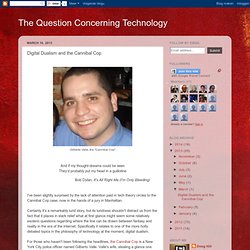

This is how stigma works. Digital Dualism and the Cannibal Cop. And if my thought-dreams could be seen They’d probably put my head in a guillotine Bob Dylan, It's All Right Ma (I'm Only Bleeding) I've been slightly surprised by the lack of attention paid in tech theory circles to the Cannibal Cop case, now in the hands of a jury in Manhattan.

Certainly it's a remarkably lurid story, but its luridness shouldn't distract us from the fact that it places in stark relief what at first glance might seem some relatively esoteric questions regarding where the line can be drawn between fantasy and reality in the era of the Internet. Specifically it relates to one of the more hotly debated topics in the philosophy of technology at the moment, digital dualism.
For those who haven't been following the headlines, the Cannibal Cop is a New York City police officer named Gilberto Valle. Valle's wife, Kathleen Mangan-Valle, testified during the trial about what her husband had in mind. This is not a question the digital theorists have ignored. ©Doug Hill, 2013. Achieving herd immunity against pseudoscience in the age of the filter bubble and the social news revolution. The Cheapest Generation - Derek Thompson and Jordan Weissmann. In 2009, Ford brought its new supermini, the Fiesta, over from Europe in a brave attempt to attract the attention of young Americans.

It passed out 100 of the cars to influential bloggers for a free six-month test-drive, with just one condition: document your experience online, whether you love the Fiesta or hate it. Young bloggers loved the car. Young drivers? Not so much. After a brief burst of excitement, in which Ford sold more than 90,000 units over 18 months, Fiesta sales plummeted. Don’t blame Ford. Adulthood, Delayed The Great Recession changed young Americans' attitudes about what it means to be an adult.by Derek Thompson In a bid to reverse these trends, General Motors has enlisted the youth-brand consultants at MTV Scratch—a corporate cousin of the TV network responsible for Jersey Shore—to give its vehicles some 20-something edge.
Perhaps. Since World War II, new cars and suburban houses have powered the economy and propelled recoveries. Visualizing Punishment » The Society Pages. Four decades ago, the United States launched a grand policy experiment.

The nation began locking up an unprecedented share of its citizens, increasing its rate of incarceration by more than 400% over the period. According to the Bureau of Justice Statistics, the number of U.S. prisoners finally stabilized in 2009, showing small declines for the first time since the 1970s. The long-term effects of this experiment are only beginning to come into focus, but they are so powerful and so concentrated in communities of color that scholars such as Michelle Alexander liken mass incarceration to a “new Jim Crow”—a wide-ranging and racialized system of social control.
This boom was unparalleled among Western developed nations. On any given day, about 2 million U.S. citizens are now behind bars and more than 3 million former prisoners are contending with labor market discrimination, loss of voting rights, difficulty securing housing, and problems reconnecting with family. Time Space Percent of U.S. It's not just criminals who feel unsafe when the police are around. The idea that police on our streets makes people feel safer is usually taken as a given.

It's the basis of the so-called "reassurance policing" agenda, which advocates higher numbers of visible front-line police. And when increased police numbers are announced, members of the public often welcome the news. "I'm all for more police on the streets," said a Chicago resident earlier this month after the announcement of increased patrols, "It makes me feel safer seeing them around my community. " A new study challenges this received wisdom. Whereas most surveys ask people to reflect on whether they'd feel safer with more visible police, Evelien van de Veer and her colleagues took a different approach, looking at how the presence of police affected people's sense of safety right at that moment. The researchers quizzed over 200 Amsterdam residents out shopping about how safe they currently felt.